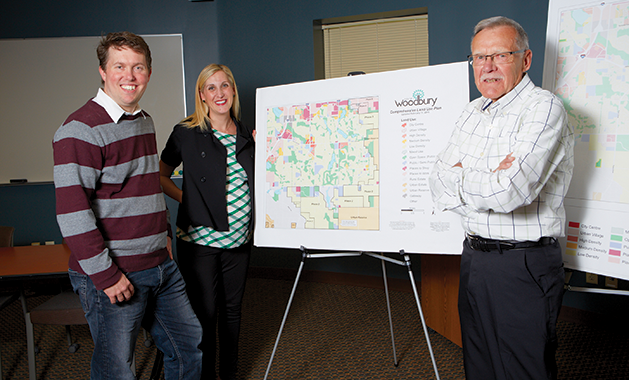
As one of the fastest growing suburbs in Minnesota, the city of Woodbury has had to exercise a cautious—and seemingly effective—approach in planning for land use, infrastructure needs and other manifestations of growth. With Woodbury celebrating its 50th anniversary this year, the city is in the process of formally planning for the next two decades of growth and change. A 12-member citizen task force and city staff are updating the 2030 comprehensive plan, which will become the 2040 comprehensive plan.
The process started last summer with hearings for public input and continued this spring with a more specific focus on land use and infrastructure. Jennifer Santini, an attorney who has lived in Woodbury since 2009, is chairperson of the task force; she previously served on the city's economic development commission. “None of us has a crystal ball, so we are trying to anticipate the city's future needs as well as changes and trends going forward,” Santini says. “We're trying to do it as strategically and wisely as possible.” Some planning issues for the city of Woodbury are more prominent than they might have been 10 or 20 years ago," Santini says. "One such example is transit."
In planning for the future, “each community is unique and is going to have its own set of guiding principles for land use, zoning codes and other things,” says Karl Batalden, the city's housing and economic development coordinator. Batalden says the 2040 comprehensive plan is now being studied to ensure the infrastructure matches the land-use plan. “There is no single area where massive change is being proposed,” he says. “It goes back to the direction we received from the City Council. They are quite happy with the vision of the community, and we're updating things.”
Task force member Roger Splinter is well-equipped to provide historical perspective. In the 1950s, he grew up on a farm located on the current site of StoneRidge Golf Club, and remembers when Woodbury was a village of 600 people. He served as chairman of the city's environmental advisory commission for five years and was a longtime member of the parks and natural resources committee. Splinter, who has an M.S and Ph.D. in chemistry, is a former Environmental Protection Agency employee and a retired environmental professor at the University of Iowa; he was also a chemistry professor at the University of Missouri and environmental laboratory director for the state of Iowa.
One of the task force’s strengths is a variety of member backgrounds, Splinter says. Members include an employee of the Minnesota Department of Natural Resources, a former farmer, a Realtor and a computer scientist.
“All of the things that make Woodbury what it is are interrelated—land use, housing, environmental, natural resources, parks, water supply, surface water management, sewage... they all have economic implications, especially when you are looking at growth,” Splinter says. “For example, we ask questions such as should we continue to plan [new] parks and trails, those kinds of things?
“The answer is an emphatic 'yes.' Sometimes people might ask, 'How can you think about things as far ahead as 2040?'” Splinter says. “My response is: We certainly better be doing that.”
Following review by the city’s planning commission and City Council, the 2040 comprehensive plan will be submitted to adjacent communities for comment, and then to the Metropolitan Council for review. For more information, go to the website here.









